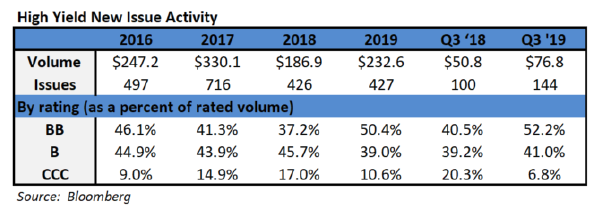Fund Flows & Issuance: According to a Wells Fargo report, flows week to date were $2.0 billion. New issuance for the week was $8.1 billion and year to date HY is at $14.2 billion.
(Bloomberg) High Yield Market Highlights
- Triple C-rated debt is leading the rally in high-yield as returns for the year jump to 1.23% and yields on the lowest tier of junk fall below 10% for the first time in seven months.
- Triple C spreads tightened 10bps to 823bps over Treasuries, according to Bloomberg Barclays index data. That’s a more than five-month low and extends a recovery from over 1,000 bps in November
- Energy is powering CCC. The energy index yield fell to 7.99%, a new six-month low
- Junk-bond yields dropped to 5.01%, just 5bps off the 5.5-year low of 4.96%. They may fall further as stock futures rise amid easing trade tensions and a solid start to the earnings season. Oil is also up this morning to almost $59 a barrel
(Bloomberg) Encompass Health Boosts Fiscal Year Operating Revenue View
- Encompass Health boosted its operating revenue forecast for the full year; the guidance midpoint met the average analyst estimate.
- Encompass sees FY operating revenue $4.59 billion to $4.61 billion, saw $4.5 billion to $4.6 billion, estimate $4.59 billion (range $4.57 billion to $4.61 billion)
- Encompass sees FY adjusted EPS from continuing operations $3.90 to $3.94, saw $3.71 to $3.85
- Encompass sees FY adjusted Ebitda $962 million to $967 million, saw $940.0 million to $960.0 million, estimate $952.2 million (range $942.0 million to $957.0 million)
- Encompass sees 2020 Adjusted EPS Continuing Operations $3.50 to $3.72, Est. $3.68
(Bloomberg) WSP Is Said to Approach Engineering Firm Aecom About Deal
- Canada’s WSP Global Inc. has approached rival engineering services firm Aecom about a possible deal, according to people familiar with the matter. There’s no guarantee that the overture will lead to a transaction, said the people, who asked to not be identified
because the matter isn’t public. - Aecom, which had been targeted by activist investor Starboard Value last year, agreed in October to sell its management services division to a group of private equity firms
for $2.4 billion. - The potential acquisition would give WSP more exposure to the U.S. and could lead to cost savings of about $200 million, Deutsche Bank analyst Chad Dillard wrote in a note to clients Tuesday.
- Aecom’s services include consulting, planning, architecture, engineering and construction management, according to its website. While it has a growing backlog thanks to a steady stream of government and infrastructure contracts, profits have stagnated in recent years due to inefficiencies and construction contract
losses, according to a Bloomberg Intelligence report in December.
(Wall Street Journal) MGM, Blackstone Strike Casino Deal
- MGM Resorts International said a joint venture that includes Blackstone Group Inc. would buy the real estate of the MGM Grand and Mandalay Bay resorts and casinos on the Las Vegas Strip, in a deal valuing the properties at $4.6 billion.
- The deal values MGM Grand’s real-estate assets at about $2.5 billion and Mandalay Bay’s at just over $2 billion.
- Blackstone will own slightly less than half of the properties through the private-equity and real-estate giant’s nonlisted real-estate investment trust, while MGM Growth Properties LLC, a publicly traded REIT, will own the remainder.
- MGM Resorts spun off MGM Growth Properties in 2016 and still controls the REIT, which owns some MGM real estate including Mandalay Bay’s.
- MGM Resorts expects to receive cash proceeds of about $2.4 billion from the deal, as well as $85 million in MGM Growth partnership units.




